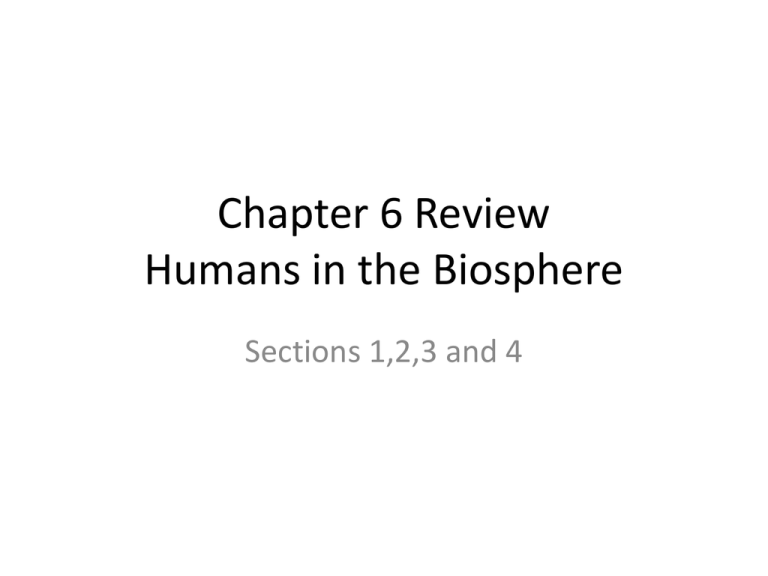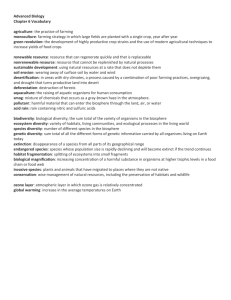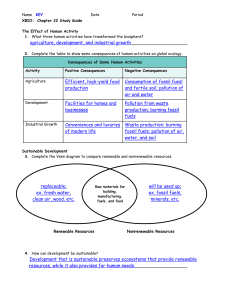Chapter 6 Review Humans in the Biosphere
advertisement

Chapter 6 Review Humans in the Biosphere Sections 1,2,3 and 4 Bell Work 6-1 A Changing Landscape All of the organisms- including humans- that live on Earth share a limited resource base and depend on it for their longterm survival. 1. Increasing demands on what resources come with a growing human population? Land, Air, Water 2. What four human activities have transformed the biosphere? Hunting and Gathering, Agriculture, Industry, & Urban Development 6-1 Hunting and Gathering 3. How did Hunters & Gatherers change the environment? They caused a major mass extinction of animals 6-1 Agriculture 4. What is agriculture? Farming 5. Why was agriculture an important event? agriculture provides human societies with a fundamental need: a dependable supply of food 6-1 6. What ecological changes came with the cultivation of both plants and animals? Pros: People became able to gather in settlements rather than moving in search for food. Cons: Overgrazing of Herbivores Large demand of Water 6-1 7. What changes occurred in the 1800s as a result of advancements in science and technology? Farmers gradually acquired machinery, such as plows and the seed drill to make work easier. 6-1 The Green Revolution Modern agricultural techniques were introduced, such as monoculture and the use of chemical fertilizers. 8. How did the green revolution benefit society? It increased food production 6-1 9. What occurred during the Industrial Revolution of the 1800s? Machines and Factories were added 6-1 To produce and power machines, we need energy. 10. From what resources do we obtain most of the energy to produce and power machines? Fossil Fuels : coal, oil, and natural gas t 6-1 As urban centers became crowded, people began to move from the cities to the suburbs: Suburban Sprawl. 11. How does the suburban sprawl place stress on the plant and animal population? it consumes farmland and animal habitats 6-2 Resources The Tragedy of the Commons Inhabitants of English villages could graze their cattle on shared pasture land called the commons. Grazing was free of charge and therefore, villages often put as many cattle out as possible. Even as the land became overused, people kept putting more cattle on it. Overgrazing on the village commons caused the pastures to deteriorate so badly that they could no longer be used to support any cattle. 6-2 The Tragedy of the Commons No one was responsible for preserving the land. 1. The idea that any resource, such as water in the ground or fish in the sea, that is free and accessible to everyone, may eventually be destroyed. 6-2 Renewable Resource • Regenerate if living or Replenished if nonliving • Not necessarily unlimited Tree: a new tree can grow in place of an old tree Freshwater: replenished through biogeochemical cycles Freshwater can easily become limited by drought or overuse 6-2 Nonrenewable Resource • Cannot be replenished by natural processes Fossil Fuels: when these fuels are gone, they are gone forever. What are three fossil fuels? coal, oil, and natural gas 6-2 3. What is sustainable development? Using natural resources without depleting them 4. How do human activities affect renewable resources? Affect the quality and supply of renewable resources such as land, forest, fisheries, air, and fresh water. 6-2 Land Resources 6. If managed properly, soil is a _____________ Renewable Resource 7. Soil Erosion is… the wearing away of surface soil by water and wind. 6-2 Land Resources 8. How does plowing the land increase the rate of soil erosion? It removes the roots that hold the soil in place 6-2 Land Resources 9. The conversion of previously soil rich area into a desert is called ________________. Desertification There are a variety of sustainable development practices that can guard against this, such as leaving the stems and roots of the plants from the previous years crop in place. 6-2 Forest Resources 10. Why have forests been called the “lungs of the Earth”? They remove carbon dioxide and produce oxygen Forests also store nutrients, provide habitats and food for organisms, moderate climate, limit soil erosion, and protect freshwater supplies. 6-2 11. What is deforestation and how does it affect the biosphere? The loss of forests can lead to soil erosion as soil is exposed to heavy rains. 6-2 Fishery Resources 12. Fish and other animals that live in water are a valuable source of ______________. Food 13. The practice of harvesting fish faster than they can reproduce is called ______________. Overfishing 6-2 Fishery Resources 14. What is one approach to sustainable use of fisheries? Controlling how many fish and of what size, could be caught in various parts of the oceans 6-2 Fishery Resources 15. What is aquaculture? Raising of aquatic animals for human consumption 6-2 Air Resources 16. What is smog? It is a mixture of chemicals that occurs as a gray-brown haze in the atmosphere. 6-2 Air Resources 17. What is a pollutant? a harmful material that can enter the biosphere through the land, air, or water Is smog a pollutant? Yes 6-2 18. How does the burning of fossil fuels affects air quality? It can release pollutants that cause smog and other problems in the atmosphere 6-2 Freshwater Resources 19. Why are protecting water supplies from pollution and managing demand for water major priorities? Freshwater is a limited resource Pollution threatens water supplies in several ways. 6-2 Freshwater Resources 20. What is water sewage and how does it threaten water supplies? Water sewage is waste water from sinks and toilets. It contains compounds that encourage algae growth and bacteria in aquatic habitats. 6-2 Freshwater Resources As water flows slowly through a swamp, densely growing plants filter certain pollutants out of the water. Similarly, forests help to purify the water that seeps into the ground or runs off into rivers and lakes. 6-3 Biodiversity 1. What is biodiversity? the sum total of the genetically based variety of all organisms in the biosphere 6-3 Ecosystem Diversity Variety of habitats, communities, and ecological processes in the living world Species Diversity The number of different species in the biosphere Genetic Diversity Sum total of all the different forms of genetic information carried by all organisms living on Earth 6-3 3. Why is biodiversity one of Earth’s greatest natural resources? species of many kinds have provided us with foods, industrial productions, and medicinesincluding painkillers, antibiotics, heart drugs, and anticancer drugs 6-3 Threats to Biodiversity 4. What are four ways that human activity can reduce biodiversity? • altering habitats • hunting species to extinction • introducing toxic compounds into food webs • introducing foreign species to new environments 6-3 Habitat Alteration As habitats disappear, the species that live in those habitats vanish. In addition, the development often splits ecosystems into pieces, a process called ___________( #7)___. Habitat Fragmentation 6-3 Demand for Wildlife Products 5. A species whose population size is declining in a way that places it in danger of extinction is called an __________________. Endangered Species Some species are hunted for meat, fur, hides, or are believed to have medicinal purposes. 6-3 6. Why does a declining population make a species more vulnerable to extinction? the species loses genetic diversity 6-3 Pollution 8. What is DDT? one of the first widely used pesticides At first, it seemed to be perfect. It is cheap, remains active for a long time, and kills many different kinds of insects. 6-3 Pollution 9. What two properties of DDT make it hazardous over the long term? • Non-Biodegradable (cannot be broken down) • It can be picked up by all organisms 6-3 Pollution 10. What is biological magnification? The process in which concentrations of harmful substances increase in organisms at higher trophic levels in a food chain/ food web. 6-3 Introduced Species Humans can easily transport seemingly harmless plants and animals around the world either accidentally or intentionally. Plants and animals that have migrated to places where they are not native are called ________. Invasive species Invasive Species reproduce rapidly due to lack to parasites and predators from “back home” They have ideal conditions for exponential growth 6-3 Conserving Biodiversity In ecology, the term conservation is used to describe the wise management of natural resources, including the preservation of habitats and wildlife. 13. What is the purpose of conservation biology? Seeks to preserve Biodiversity 6-4 Charting a Course for the Future Researchers are gathering data to monitor and evaluate the effects of human activities on important systems in the biosphere. Two of these systems are the ozone layer and the global climate system. 1. What is ozone? Ozone gas has 3 oxygen molecules It is found in the Earth’s atmosphere Ozone Layer 6-4 Ozone Depletion 2. What is causing the problem of ozone depletion? gases called chlorofluorocarbons or CFCs 6-4 Global Climate Change 3. What is Global Warming? The increase in average temperature of the biosphere 4. What is the most widely accepted hypothesis about the cause of global warming? human activity 6-4 Global Warming 5. If global warming continues at the current rate, how might sea levels be affected? Sea levels will rise due to melting polar ice caps 6-4 Value of a Healthy Biosphere 6. What goods and services do a healthy biosphere provide to us? The raw materials for food and medicine 7. What is the most important shift that a society can make to solve todays ecological problems? Energy conservation 6-4 8. What is the first step in charting a course that will improve living conditions without harming the environment? Understanding we are part of the ecosystem Let’s see how much you remember Chapter 6: test your knowledge 1. What is always true of a renewable resource? a. b. c. d. D It creates no pollution It is instantly replaced It is unlimited It is replaceable by natural means Chapter 6: test your knowledge 2. Ozone depletion has been caused by a. monoculture b. suburban sprawl c. aquaculture d. CFCs D Chapter 6: test your knowledge 3. Concentrations of harmful substances increase in organisms at higher trophic levels in a food chain. This process is called: a. aquaculture b. monoculture c. pesticide use d. biological magnification D Chapter 6: test your knowledge 4. Which of the following human activities was NOT important in transforming the biosphere? a. agriculture b. industry c. aquaculture d. urban development C Chapter 6: test your knowledge 5. Civilizations could not develop without a. monoculture b. hunter-gatherers c. agriculture d. crop exchange C









